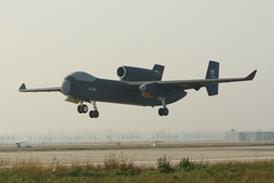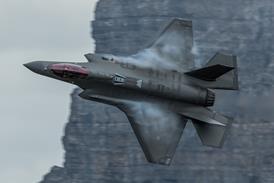Chinese aerospace factories are moving gradually to civil aircraft work after years of focusing on military projects. But will their pursuit of Western partners pay off?
Chinese manufacturers are steadily increasing their participation in commercial aircraft programmes in an effort to build their aerospace manufacturing capabilities and find new sources of revenue beyond traditional defence work.
Manufacturing conglomerate China Aviation Industry I (AVIC I) is seeking supplier deals on the new Boeing 7E7 and to expand its role in a number of existing commercial aircraft projects. China Aviation Industry II (AVIC II) is trying to break into the commercial aircraft components business and build on its fast-growing portfolio of locally assembled Western aircraft, which includes several helicopter types and the Embraer ERJ-145 regional jet.
AVIC I's factories in Chengdu, Shenyang and Xian all are in line to build components for the 7E7. They are already suppliers to Airbus and Boeing and are looking to expand their commercial business to keep their large workforces busy. The factories have huge excess capacity and are overstaffed, but new advanced manufacturing equipment is being delivered as the government and foreign partners invest in improving the facilities' efficiency.
"The Chinese government thinks the aerospace industry is important for economic reasons," says an industry source. "Equally important, the techniques and processes they will learn have direct translations to their defence programmes."
Another industry source says factories must secure new commercial contracts to offset reductions in military aircraft spending during peacetime. China's major factories are working on new military programmes, but the huge facilities built to keep up with demand during times of war have more than enough capacity to satisfy growing interest from overseas manufacturers in sourcing parts in low-cost China.
Military sales still account for over 70% of revenues at Shenyang and fighters, including the indigenous J-8/F-8 and local production of Sukhoi Su-27s, will continue to account for most of its business. But the company has steadily been building its commercial component business since lining up its first foreign partners in 1985.
The Chinese are also keen to switch to Westernised production techniques for indigenously developed aircraft and to source materials for these aircraft abroad. Technology gleaned from commercial programmes will help Chinese manufacturers develop and build the AVIC I ARJ21, a new large regional jet due to fly in 2006, plus future military aircraft programmes.
"They don't make a lot of money on commercial stuff - sometimes they lose money," says an industry source. "They are pursuing more commercial stuff, especially on the 7E7, because they convert the processes and materials into their own aircraft."
7E7 agreements
In June, AVIC I signed a series of preliminary agreements covering 7E7 parts and assemblies. AVIC I is now negotiating final contracts with first-tier 7E7 suppliers and will then distribute the work to its factories.
Chengdu has been earmarked for the 7E7 rudder. This contract, still not completed, will help Chengdu offset the end of Boeing 757 production, for which it supplied horizontal stabilisers, fins and tail sections.
Shenyang and Xian are in line to produce metal parts for the 7E7. Shenyang now supplies a section of the 737 tail and supplied cargo doors for the 757. Xian supplies vertical fins for the 737 and trailing-edge ribs for the 747. In September it added a contract for floor beams for the new 747-400 Special Freighter. An AVIC I factory in Shanghai builds horizontal stabilisers for the 737.
Boeing, which began industrial co-operation with China in the mid-1970s, opened a joint venture facility with AVIC I and Hexcel in Tianjin in 2002. BHA Aero Composite Parts supplies components for interiors and secondary structures used in several aircraft types. Sources say BHA is in line to supply ducts and perhaps other small parts for the 7E7.
The Shanghai factory is not pursuing 7E7 work because most of its capacity will be used to assemble the ARJ21. Chengdu, Shenyang and Xian are also building ARJ21 components, but have more capacity than Shanghai. Military aircraft production still dominates the large Chengdu, Shenyang and Xian factories. Shanghai's last major project, assembly of the Boeing MD-90 TrunkLiner, finished in 2000 because of a lack of sales to Chinese carriers. Only two aircraft were produced.
Chengdu, Shenyang and Xian are also growing quickly as suppliers for Airbus. In June, Shenyang added a contract for A330 and A340 forward cargo doors, and the factory is negotiating to expand its participation in the A320 programme. Shenyang already supplies emergency doors and wing subassemblies for A320 family aircraft. Xian is also an A320 supplier, producing trailing-edge and leading-edge wing structures. In June, AVIC I won its first Airbus A380 contract, covering upper and lateral panels of the nose landing-gear bay.
AVIC I's major factories are also involved with turboprop aircraft - Shenyang produces doors for the Bombardier Dash 8 and Xian rear fuselages for the ATR 42. During the last decade Xian developed the MA60 turboprop - but the few sold are grounded following reliability problems and two runway overruns.
AVIC I hopes that the ARJ21, led by new Shanghai-based subsidiary AVIC I Commercial Aircraft Company (ACAC), will improve China's track record after the failures of the MD-80/90 and MA60. ACAC has already sold the aircraft to domestic operators and hopes its decision to build the aircraft with Western raw materials, avionics and engines will win overseas customers. But many industry observers doubt the aircraft will be sold outside China and say, more importantly, the project gives local manufacturers an opportunity to learn about new technologies and gain a glimpse of what it is like to compete in the global aircraft manufacturing market.
Earlier this year AVIC I launched a study to determine whether it can compete in the narrowbody market. Observers say China is likely to decide next year that such a project is much too risky and will instead focus on more feasible exports, such as components and the sale of military aircraft to second-tier foreign air arms.
At AVIC II, the focus is on forging partnerships with Western manufacturers. Its Harbin factory, home of Harbin Aircraft Industry and Hafei Aviation Industry, is in line to supply composite fairings for the 7E7 and is pursuing other composite commercial aircraft supplier deals.
Harbin has developed composite capabilities through its work on Eurocopter helicopter programmes. It manufactures the Z-9, an indigenous version of the Eurocopter AS365 Dauphin, and assembles the Eurocopter EC120. The factory also plans assembly of the Eurocopter EC135 and to supply Bell with Model 430 cabins.
Harbin is also in a position to produce components for Embraer regional jets as an expansion of its joint venture with the Brazilian manufacturer. The joint venture delivered the first Chinese-assembled ERJ-145 in July, but the entire fuselage is produced in Brazil and shipped to China. Harbin is preparing to start production of fuselage frames, however, and Embraer is considering sourcing fuselage barrels and fairings at the company. Initially, Harbin will only produce components for aircraft assembled in China.
Changhe remains focused on helicopters, with a growing push towards the civil market. The factory produces the indigenousZ-8, Z-10 and Z-11 for the military, but it is developing new re-engined civil versions of the Z-11 and Z-8. Changhe also plans local assembly of the Agusta Westland A109 and to supply components for A109s produced abroad. It is also courting Western partners to develop a 10,000kg utility helicopter.
GA hopes
Another AVIC II factory at Hongdu is focused on military trainers and general aviation. Hongdu is developing an upgraded version of its N-5 agricultural aircraft and plans local assembly of the MD Helicopters MD 500/600. Hongdu, Shenyang and several smaller aerospace manufacturers are also looking to launch small fixed-wing manufacturing projects to take advantage of the anticipated opening of the Chinese general aviation market (see P34).
Industry sources say Chinese aerospace factories have improved, particularly with production efficiency and modern equipment. But they also warn that sourcing work in China can be difficult because although factories have underused assets and aggressively seek to win new jobs at competitive rates, they often fail to deliver.
"It's like a catch-22," says one source. "They still have efficiency problems and have trouble ramping up production."
BRENDAN SOBIE / BEIJING
Source: Flight International























